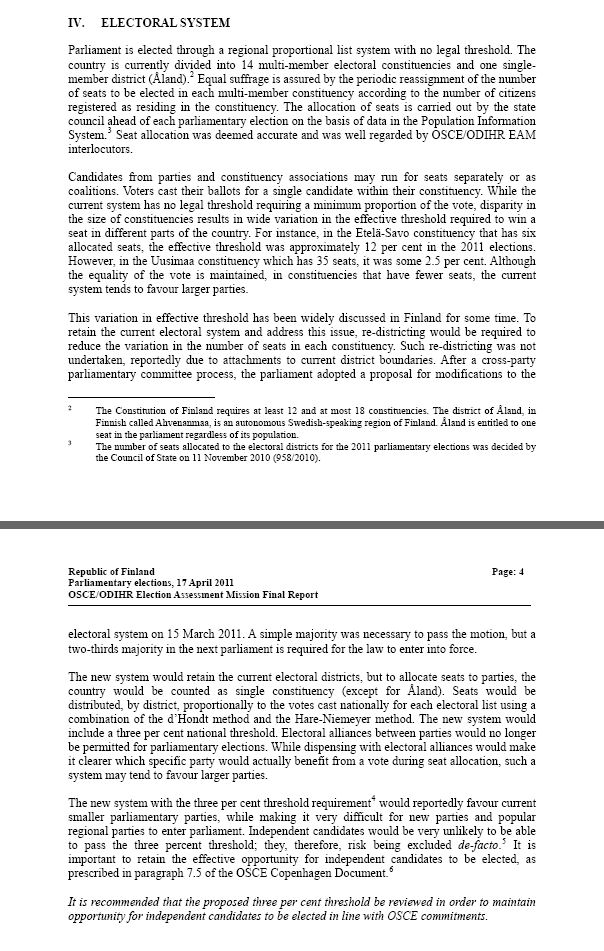Isän kädestä: Ohjeita ex-oikeusministeri Braxille. Etyj:n vaaliraportti.
Ministeri Brax intoili kolmen prosentin äänikynnyksen puolesta. Tietenkin muutkin. Esitys jopa hyväksyttiin edellisessä eduskunnassa ja uuden sen pitäisi hyväksyä, jotta se tulisi voimaan. Kokoomuksen Kimmo Sasille lienee tihkunut ennakkotietoja EtyJ:n raportista, koska hän on ilmoittanut, ettei kokoomus sitä hyväksy, enää. SDp:hän on vastustanut sitä koko ajan ja huvittavasti myös perussuomalaiset, Timo Soini, on ilmoittanut myös sitä vastustavansa.
Edellisen oikeusmnisteri Tuija Braxin lausuntoja ei ole kuulunut. Ehkei kuulukaan. Ehkä hän on mennyt jonnekin nurkkaan häpeämään häpeämättömyyttään.
Tähän liitteeksi Etyj:in raportin ko asiaa koskeva sivu sellaisenaan.
Viikkosanomat. Pertti Manninen. Lauantai 2011-07-23 klo 03:18.
Linkki.
Silmänkääntö- ja temppuministeri pilkkaa perustuslakia oikeusministerin valekaavussa!
http://www.nettisanomat.com/2008/04/25/etusivu.htm
ja vielä pakkoruotsi-hömppää:
Oikeusministeri Tuija Brax pilkkaa perustuslakia!
http://viikkosanomat.fi/2010/10/05/oikeusministeri-tuija-brax-pilkkaa-perustuslakia/
—
2
The Constitution of Finland requires at least 12 and at most 18 constituencies. The district of Åland, in Finnish called Ahvenanmaa, is an autonomous Swedish-speaking region of Finland. Åland is entitled to one seat in the parliament regardless of its population.
3
Parliament is elected through a regional proportional list system with no legal threshold. The country is currently divided into 14 multi-member electoral constituencies and one single-member district (Åland).
Candidates from parties and constituency associations may run for seats separately or as coalitions. Voters cast their ballots for a single candidate within their constituency. While the current system has no legal threshold requiring a minimum proportion of the vote, disparity in the size of constituencies results in wide variation in the effective threshold required to win a seat in different parts of the country. For instance, in the Etelä-Savo constituency that has six allocated seats, the effective threshold was approximately 12 per cent in the 2011 elections. However, in the Uusimaa constituency which has 35 seats, it was some 2.5 per cent. Although the equality of the vote is maintained, in constituencies that have fewer seats, the current system tends to favour larger parties.
This variation in effective threshold has been widely discussed in Finland for some time. To retain the current electoral system and address this issue, re-districting would be required to reduce the variation in the number of seats in each constituency. Such re-districting was not undertaken, reportedly due to attachments to current district boundaries. After a cross-party parliamentary committee process, the parliament adopted a proposal for modifications to the Republic of Finland Page: 4
2 Equal suffrage is assured by the periodic reassignment of the number of seats to be elected in each multi-member constituency according to the number of citizens registered as residing in the constituency. The allocation of seats is carried out by the state council ahead of each parliamentary election on the basis of data in the Population Information System.3 Seat allocation was deemed accurate and was well regarded by OSCE/ODIHR EAM interlocutors.
electoral system on 15 March 2011. A simple majority was necessary to pass the motion, but a two-thirds majority in the next parliament is required for the law to enter into force.
The new system would retain the current electoral districts, but to allocate seats to parties, the country would be counted as single constituency (except for Åland). Seats would be distributed, by district, proportionally to the votes cast nationally for each electoral list using a combination of the d’Hondt method and the Hare-Niemeyer method. The new system would include a three per cent national threshold. Electoral alliances between parties would no longer be permitted for parliamentary elections. While dispensing with electoral alliances would make it clearer which specific party would actually benefit from a vote during seat allocation, such a system may tend to favour larger parties.
The new system with the three per cent threshold requirement
4 would reportedly favour current smaller parliamentary parties, while making it very difficult for new parties and popular regional parties to enter parliament. Independent candidates would be very unlikely to be able to pass the three percent threshold; they, therefore, risk being excluded
—
OSCE/ODIHR Election Assessment Mission Report
http://www.osce.org/odihr/81121
Office for Democratic Institutions and Human Rights
REPUBLIC OF FINLAND
PARLIAMENTARY ELECTIONS
17 April 2011
 Lue myös!
Lue myös!
Janne Paalijärvi, poliittinen piraatti
http://usvi.puheenvuoro.uusisuomi.fi/78641-etyjin-tarkkailijat-eduskuntavaaleista-aanikynnys-ongelmallinen
–
Tags: äänikynnys, Kimmo Sasi, oikeusministeri, Timo Soini, Tuija Brax, vaaliraportti